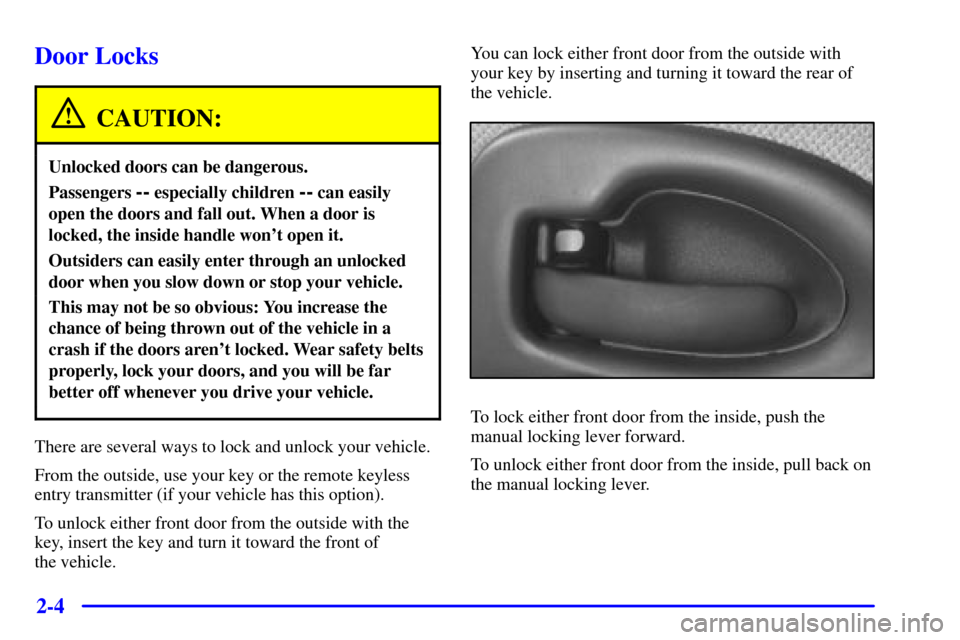Page 100 of 429
1-88
�If your vehicle doesn't have the child restraint
locking feature on the shoulder belt retractor,
tighten the belt by pulling up on the shoulder belt
while you push down on the child restraint. You
may find it helpful to use your knee to push down
on the child restraint as you tighten the belt.
7. Push and pull the child restraint in different
directions to be sure it is secure.
To remove the child restraint, just unbuckle the vehicle's
safety belt and let it go back all the way. The safety belt
will move freely again and be ready to work for an adult
or larger child passenger.Larger Children
Children who have outgrown child restraints should
wear the vehicle's safety belts.
If you have the choice, a child should sit next to a
window so the child can wear a lap
-shoulder belt and
get the additional restraint a shoulder belt can provide.
Page 108 of 429

2-4
Door Locks
CAUTION:
Unlocked doors can be dangerous.
Passengers -- especially children -- can easily
open the doors and fall out. When a door is
locked, the inside handle won't open it.
Outsiders can easily enter through an unlocked
door when you slow down or stop your vehicle.
This may not be so obvious: You increase the
chance of being thrown out of the vehicle in a
crash if the doors aren't locked. Wear safety belts
properly, lock your doors, and you will be far
better off whenever you drive your vehicle.
There are several ways to lock and unlock your vehicle.
From the outside, use your key or the remote keyless
entry transmitter (if your vehicle has this option).
To unlock either front door from the outside with the
key, insert the key and turn it toward the front of
the vehicle.You can lock either front door from the outside with
your key by inserting and turning it toward the rear of
the vehicle.
To lock either front door from the inside, push the
manual locking lever forward.
To unlock either front door from the inside, pull back on
the manual locking lever.
Page 134 of 429

2-30 Sliding Door Security Lock
Your vehicle is equipped with a sliding door security
lock that helps prevent young children or other
passengers from opening the sliding door by using the
inside door handle.
The security lock lever is located on the inside of the
sliding door, on the front edge of the door. To access the
lever, open the sliding door. Use the security lock label
on the edge of the door as a guide. This lock is on both
doors if your vehicle is equipped with dual sliding doors.
To use the security lock,
move the security lock lever
all the way up and close the
door from the outside.If your vehicle is equipped with a power sliding door,
you can override the security lock by pressing either
power door switch when the power sliding door is
turned off. When the power sliding door is turned on,
the power sliding door cannot be opened from the inside
when the sliding door security lock is in use.
If you want to open the sliding door when the security
lock is on, unlock the sliding door and open the door
from the outside.
You should let adults and older children know how the
security lock works, and how to cancel the lock. If you
don't, adults or older children who ride in the rear won't
be able to open the sliding door from the inside when
the security lock feature is in use.
Page 262 of 429

4-12 Steering in Emergencies
There are times when steering can be more effective
than braking. For example, you come over a hill and
find a truck stopped in your lane, or a car suddenly pulls
out from nowhere, or a child darts out from between
parked cars and stops right in front of you. You can
avoid these problems by braking
-- if you can stop in
time. But sometimes you can't; there isn't room.
That's the time for evasive action
-- steering around
the problem.
Your vehicle can perform very well in emergencies like
these. First apply your brakes. (See ªBraking in
Emergenciesº earlier in this section.) It is better to
remove as much speed as you can from a possible
collision. Then steer around the problem, to the left or
right depending on the space available.
An emergency like this requires close attention and a
quick decision. If you are holding the steering wheel at
the recommended 9 and 3 o'clock positions, you can
turn it a full 180 degrees very quickly without removing
either hand. But you have to act fast, steer quickly, and
just as quickly straighten the wheel once you have
avoided the object.
The fact that such emergency situations are always
possible is a good reason to practice defensive driving at
all times and wear safety belts properly.